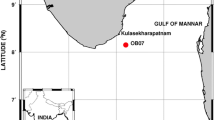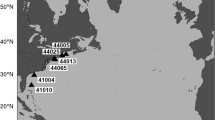Abstract
The focus of the present study is the assessment of the impact of wind forcing on the spectral wave model MIKE 21 SW in the Indian Ocean region. Three different wind fields, namely the ECMWF analyzed winds, the ECMWF blended winds, and the NCEP blended winds have been used to drive the model. The wave model results have been compared with in-situ observations and satellite altimeter data. This study also evaluated the performance of the wind products during local phenomenon like sea breeze, since it has a significant impact on the wave prediction in the Indian coastal region. Hence we explored the possibility of studying the impact of diurnal variation of winds on coastal waves using different wind fields. An analysis of the model performance has also been made during high wind conditions with the inference that blended winds generate more realistic wave fields in the high wind conditions and are able to produce the growth and decay of waves more realistically.











Similar content being viewed by others
References
Aparna M, Shetye S R, Shankar D, Shenoi S S C, Mehra P, and Desai R G P 2005 Estimating the seaward extent of sea breeze from QuikSCAT scatterometry; Geophys. Res. Lett. 32 L13601, doi: 10.1029/2005GL023107.
Ardhuin Fabrice, Chapron Bertrand and Collard Fabrice 2009 Observation of swell dissipation across oceans; Geophys. Res. Lett. 36(L06607) 1–5, doi: 10.1029/2008GL037030.
Battjes J A and Janssen J P F M 1978 Energy loss and set-up due to wave breaking of random waves; In: Proc. 16th Int. Conf. Costal Eng., ASCE, pp. 569–587.
Bentamy A, Ayina H -L, Queffeulou P, Croize-Fillon D, and Kerbaol V 2007 Improved near real time surface wind resolution over the Mediterranean Sea; Ocean Sci. 3 (2) 259–271.
Bidlot J -R, Holmes D J, Wittmann P A, Lalbeharry R, and Chen H S 2002 Intercomparison of the performance of operational ocean wave forecasting systems with buoy data; Wea. Forecast. 17 287–310.
Cavaleri L 1994 Applications to wave hindcasting and forecasting; Chapter IV; In: Dynamics and Modeling of Ocean Waves, Cambridge University Press, UK, 532p.
Chin T M, Milliff R F, and Large W G 1998 Basin-scale high-wave number sea surface wind fields from a multi resolution analysis of scatterometer data; J. Atmos. Oocean. Technol. 15 741–763.
DHI 2005 Mike21 spectral wave module, Scientific documentation; Danish Hydraulic Institute (DHI).
Feng H, Vandemark D, Quilfen Y, Chapron B, and Beckley B 2006 Assessment of wind-forcing impact on a global wind-wave model using the topex altimeter; Ocean Eng. 33 1431–1461.
Govindan R, Kumar R, Basu S, and Sarkar A 2011 Altimeter derived ocean wave period using genetic algorithm; IEEE Geosci. Rem. Sens. Lett. 8 354–358.
IOC IHO and BODC 2003 Centenary edition of the GEBCO Digital Atlas published on CD-ROM on behalf of the Intergovernmental Oceanographic Commission and the International Hydrographic Organization as part of the General Bathymetric Chart of the Oceans; British Oceanographic Data Centre, Liverpool.
Komen G J, Cavaleri L, Donelan M, Hasselmann K, Hasselmann S and Janssen P A E M 1994 Dynamics and modeling of ocean waves; Cambridge University Press, UK, 560p.
Kumar R et al. 2000 Ocean wave model sensitivity experiments; Preprints, Fifth Pacific Ocean remote sensing Conf. (PORSEC), Goa, India, pp. 801–803.
Masselink G and Pattiarchi C B 1998 The effect of sea breeze on beach morphology surf zone hydrodynamics and sediment resuspension; Mar. Geol. 46 115– 135.
Milliff R F, Large W G, Morzel J, Danabasoglu G and Chin T M 1999 Ocean general circulation model sensitivity to forcing from scatterometer winds; J. Geophys. Res. C5 11,337–11,358.
Milliff R F, Morzel J, Chelton D B, and Freilich M H 2004 Wind stress curl and wind stress divergence biases from rain effects on QSCAT surface wind retrievals; J. Atmos. Ocean. Tech. 21 1216–1231.
Neetu S, Shetye S, and Chandramohan P 2006 Impact of sea-breeze on wind-seas off Goa, west coast of India; J. Earth. Syst. Sci. 115 229–234.
Persson A and Grazzini F 2007 User guide to ECMWF forecast products; Meteorol. Bull. M3 (24) 1–46.
Reddy M P M 2001 Descriptive physical oceanography; A A Balkema Publishers, Netherlands, 440p.
Rogers Erick W, Wittmann P A, Wang D W C, Clancy R M, and Hsu Y L 2005 Evaluations of global wave prediction at the Fleet Numerical Meteorology and Oceanography Center; Wea. Forecast. 20 745– 760.
Sørensen O R, Kofoed-Hansen H, Rugbjerg M, and Sørensen L S 2004 A third generation spectral wave model using an unstructured finite volume technique; Proc. 29th Int. Conf. Costal Eng., Lisbon, Portugal.
Tolman 1998 Effects of observation errors in linear regression and bin-average analyses; Quart. J. Roy. Meteorol. Soc. 124 897–917.
Young I R 1999 Wind-generated ocean waves; Elsevier Ocean Engineering Book Series 2.
Acknowledgements
This work was done as part of PhD work of Remya P G while she was at Space Applications Centre. Authors wish to thank the Director, Space Applications Centre, the Deputy Director, Earth, Ocean, Atmosphere, Planetary Sciences and Applications Area and the Group Director, Atmospheric and Oceanic Sciences Group, for motivation and encouragement. The in-situ data for the analysis was provided by National Institute of Ocean Technology, MoES, India. The authors wish to thank Delft Institute for Earth Oriented Space Research Radar Altimeter Database system (http://rads.tudelft.nl/rads/rads.shtml) for providing radar altimeter data. QSCAT/NCEP blended wind data were obtained through the GEBCO Digital Atlas published by the British Oceanographic Data Centre on behalf of IOC and IHO, 2003; website http://dss.ucar.edu/datasets/ds744.4/. Authors also wish to thank two anonymous reviewers for their valuable suggestions. The corresponding author would like to thank the Director, Indian National Centre for Ocean Information Services, Ministry of Earth Sciences, Govt. of India, Hyderabad, for encouragement and support. This is INCOIS contribution no. 195.
Author information
Authors and Affiliations
Corresponding author
Rights and permissions
About this article
Cite this article
Remya, P.G., Kumar, R. & Basu, S. An assessment of wind forcing impact on a spectral wave model for the Indian Ocean. J Earth Syst Sci 123, 1075–1087 (2014). https://doi.org/10.1007/s12040-014-0450-z
Received:
Revised:
Accepted:
Published:
Issue Date:
DOI: https://doi.org/10.1007/s12040-014-0450-z




